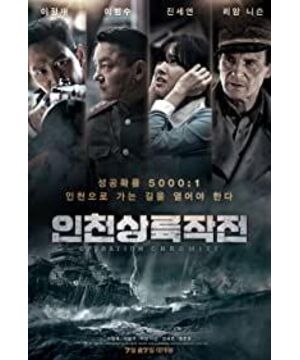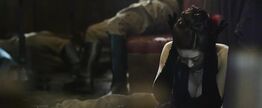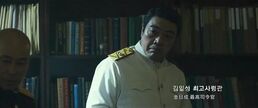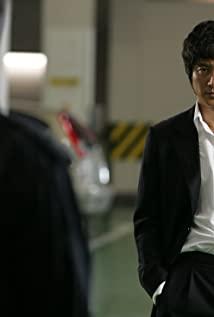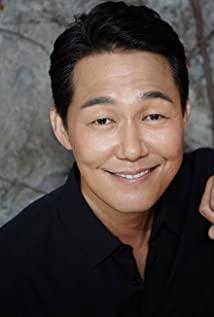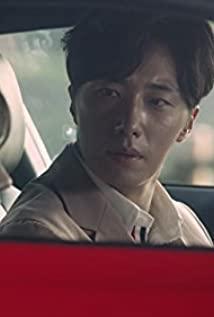Originally published in the 10th issue of "Watching Movies Midnight" in 2016, due to the limited space specified by the magazine, I always feel that I have not explained it thoroughly, and it is quite unfinished:
In 2016, although the international war film market is not yet "green and yellow", it is indeed not as rich as 2015 under the banner of "the 70th anniversary of the victory of the World Anti-Fascist War". Although there is no special historical anniversary, both China and South Korea in 2016 aimed at the Korean War as the theme of war movies. However, for the film "Incheon Landing Operation", military fans may "go away with the excitement and return in disappointment". This is reminiscent of the words of British Prime Minister Winston Churchill during World War II when he commented on the Anchio landing campaign: "We originally hoped to throw a ferocious wild cat ashore, but what we didn't expect was a stranded whale."
Commander is not "Smecta"
With the increasing IQ of the audience and the increasingly critical eyes of military fans, in addition to the Chinese film market, international war films have basically abandoned the "war dramas" made up indiscriminately. These days, if war films do not have "historical prototypes" and are not based on "real history", directors and screenwriters are embarrassed to say hello to people.
Director Lee Jae-han obviously knows this very well. Before other Korean directors, he brought the "Battle of National Salvation", which can be called a turning point in Korean history, onto the screen. However, this so-called "war movie" can actually only be regarded as a "spy war movie" or "action movie". Its main role lies in the intelligence warfare and special operations before the Inchon landing battle, and the "landing" has become a "gimmick". In order to attract the attention of the audience, it is really disgusting to use the means of "title party".
On June 25, 1950, North Korea launched an attack on South Korea, and the Korean War broke out. Five years after Japan's surrender, the Korean Peninsula under the state of division between the North and the South has reignited the war. The Korean People's Army under the Soviet Union has advanced weapons and equipment, and a large number of soldiers are Korean officers and soldiers who have participated in the Chinese Liberation War. In the face of the frail South Korean army and the inadequately prepared U.S. military, the North Korean army was on a tear, suppressing the U.S.-South Korean coalition forces in the "Busan Defense Circle". As the commander-in-chief of the "United Nations", U.S. Army five-star General Douglas MacArthur, despite all the opposition, insisted on landing in Incheon, where the battlefield environment was extremely unfavorable for amphibious operations. In this battle, which was claimed to have a success rate of only "1 in 5,000", MacArthur unexpectedly won the battle, cutting off the logistics supply line of the North Korean army, causing the complete collapse of the North Korean army besieging the "Busan Defense Circle". This is the historical background of the movie "Incheon Landing Operation".
In the film, the "X-ray" operation carried out by the Korean death squads almost had a "decisive impact" on the success of the campaign. The historical prototype of Operation X-ray is Operation Trudy Jackson in the Battle of Inchon. Operation "X-ray" in the movie is a fictionalized version of Operation Trudy Jackson. In fact, the action and intensity of the action is far less significant or thrilling than it is portrayed in the movie.
In real history, the commander of the operation was U.S. Navy Captain Eugene Clark, not the South Korean officer shown in the movie. At that time, Captain Clark did have two Korean military assistants, Colonel Ju In-soo of the Korean Army's Counterintelligence Department and Captain Yoon Jong of the Korean Navy. However, based on the concept of "the whole universe belongs to Korea", the film naturally wants to replace the commander with a Korean. After Clark and his party arrived at Lingxing Island near Incheon, they organized local civilians to establish armed forces, reconnaissance the defense of the North Korean army, and repelled the North Korean army's tentative attack. As for the "magic drama" in the movie - the Han army death squad pretended to be the North Korean army to infiltrate the enemy's camp to steal intelligence, kill the Quartet in the rear of the North Korean army, a dozen people wiped out hundreds of North Korean soldiers, etc., the audience will watch it as an entertainment film. Well, don't take it seriously at all. Perhaps the director also felt that it seemed "unscientific" to exclude the U.S. military, so during the raid on the Wolmi Island lighthouse, English-speaking U.S. officers and soldiers suddenly appeared. However, in the previous episodes, it was never shown that there were US troops in the death squads, disguising themselves as North Korean troops for intelligence warfare in the enemy-occupied area, what about the white US troops? For these logically unjustifiable loopholes, the film did not explain anything, which became an obvious failure.
At the end of the movie, in order to make the atmosphere more tragic, "Zhang Xuexiu" made a heroic sacrifice after launching the key flare. In the real history, Cui Kyufeng, who actually fired the flare, lived until after the war. On September 15, 2010, he also participated in the reenactment of the Inchon landing.
The props can still be seen
Like a lot of female viewers watch Fury just to see Brad Pitt. When female audiences watch "Incheon Landing Operation", I am afraid they only watch "Oppa". For ordinary male audiences, war movies only need to be lively. Only military fans will use a critical eye to "experts see the doorway". Whether the props of weapons and equipment are real or not is the biggest point of view.
In the movie, the firearms equipped by the North Korean army include the German C96 "Mauser" 7.63mm pistol, the Soviet TT-33 "Tokarev" 7.62mm pistol, and the PPSh-41 "Bobosha" 7.62mm submachine gun (equipped with 71-round loading drum), M1891/30 "Mosin-Nagan" 7.62mm rifle and RP-46 7.62mm light machine gun. When the Korean death squads disguised themselves as North Korean troops, they all used the above-mentioned Soviet-made weapons. After exposure, they switched to the American M1 7.62mm carbine, M3 "Gade" 11.43mm submachine gun, M1919A4 "Browning" 7.62mm heavy machine gun and Mk Type 2 grenade. The underground armed forces of the Korean Army are also equipped with M1 "Thompson" 11.43mm submachine guns. The U.S. Marine Corps uses the M1 Garand 7.62mm semi-automatic rifle.
In the car chase clip, the North Korean army has a BA-64 armored vehicle. What is incredible is that the lead is not the BA-64, but the unprotected Jeep. In the pursuit, the North Korean army on the BA-64 actually used the US-made M20 "Super Bazooka" 88.9mm anti-tank rocket launcher. In a stationary state, the hit rate of the rocket launcher is very limited, and it is difficult to imagine that it can hit a moving vehicle in a maneuvering state. In reality, such a brain-dead tactic is basically impossible.
During the raid on Wolmido Island, the Korean death squad captured an open-top armored combat vehicle, which completely destroyed the North Korean coastal defense artillery positions. In fact, it was a prop car that "played" the Soviet SU-76M self-propelled gun. It's just that this prop car doesn't look like much. The real SU-76M, the fighting compartment is further back. The Korean death squad knew how to drive a SU-76M to fight without learning, and also destroyed a T-34/85 medium tank of the North Korean army. In fact, the operation of armored combat vehicles is impossible without professional training. The film also greatly exaggerated the strength of the North Korean army, setting the coastal defense artillery in its mountain fortifications to the Soviet M1931 (B-4) 203mm heavy siege howitzer. In fact, the 2nd Artillery Battalion of the North Korean Army's 918th Coastal Defense Artillery Regiment on Yuewei Island has only 8 M1942 (Zis-3) 76.2mm anti-tank guns, and the power is far less exaggerated than in the movie. In the real history, the 10 armor-piercing projectiles it fired hit two U.S. destroyers, but did not cause serious damage.
When the film was nearing the end, the landing began. Director Lee Jaehan finally dared to stand up and said that he was shooting a landing battle. The US F-4U "Pirate" fighter, B-29 "Superfortress" strategic bomber, various types of aircraft carriers, battleships, heavy cruisers, light cruisers, destroyers, transport ships and landing ships all appeared. Although they are all made of computer special effects, the visual effects prepared by sea and air firepower can still hold up the scene. In contrast, the sound effects are not realistic enough-the sound of the 406mm naval guns of the USS Missouri is very loud, but the sound of the guns in the movie is similar to the effect of hitting the wall when the neighbor's house is renovated. It is worth mentioning that among the U.S. fleet shelled on the other side, there are tank landing ships equipped with rocket launchers, also known as "rocket launchers". Few movies can show this detail of the US landing fleet, which is commendable.
does not restore history
In any case, in the history of the Inchon landing battle, the protagonists were the US military, and the Korean army only played a supporting role. Even in the movie, where MacArthur worked so hard, the deployment of mines in the "flying fish" waterway dreamed of by the Korean army's death squads was just wishful thinking to increase the tension of the plot. In real history, the North Korean army has deployed very few mines in Inchon, and the deployment method is also very simple. At low tide, the mines were exposed, and the US destroyers destroyed a lot with their naval guns. The landing craft entered the channel at high tide and did not hit the mine.
The portrayal of historical figures in the film is also lackluster. It is never thankless to shape someone as complex as MacArthur. In the movie MacArthur, Gregory Peck wasn't even successful enough. The North Korean coastal defense commander "Lin Guizhen" looks more like a combination of a Soviet political commissar and a gangster leader. Kim Il-sung, who is wearing breeches, is not portrayed as a "clown". He has a bit of Stalin's demeanor, but it is hard to imagine such a cold-blooded dictator who can tolerate "Lin Guizhen" yelling in front of him as in the movie. Call.
The movie still has not escaped the rut that the characters with strong family relationships such as wives, children, and mothers are bound to die. The sudden addition of the emotional drama is even more out of nothing, which really makes people wonder if this is the sequelae of the director's love film too much. This war movie was originally more like an "action movie". After adding this inexplicable love, it became a "love action movie", but it seemed that something was wrong...
In this way, Lee Jaehan created a war drama of "a dozen people save Korea". This idea of "taking the small for the big" was once reflected in his production of "Towards the Fire", and it was even the epitome of the entire Korean national cultural thought. The war drama has become less and less marketable, Smecta, let's accept the magical power!
View more about Battle for Incheon: Operation Chromite reviews


